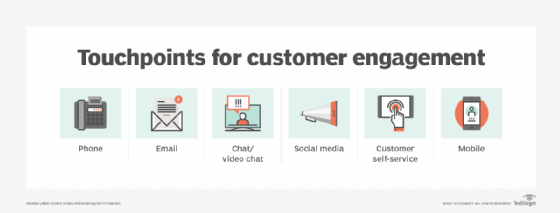
Getty Images/iStockphoto
6 challenges of omnichannel marketing
When marketers use omnichannel strategies to engage customers across touchpoints, they often face challenges with personalization, campaign tracking and brand consistency.
Omnichannel marketing can increase conversion rates, but implementing it requires complex tools and strategies.
Customers want to engage and shop with brands on their preferred channels, whether that be in-store, on social media or through email. To meet these expectations, organizations need omnichannel strategies, which help marketing and sales teams offer a smooth and consistent CX across touchpoints. Omnichannel marketing makes campaigns more effective and improves customer loyalty, but organizations might struggle to coordinate outreach across multiple channels as they attempt to personalize messaging, track campaign effectiveness and maintain brand consistency.
Explore six omnichannel marketing challenges that can occur as organizations engage customers on- and offline.
1. Creating a personalized experience
Effective omnichannel marketing requires organizations to send customers relevant content based on their past interactions with the brand. Yet, the increase in interaction channels, such as web, social media and text, creates data siloes that can hinder marketers' ability to track engagement.
To overcome this challenge, marketing leaders can aggregate customer data from all marketing, sales and service channels into a single source of truth (SSOT), which is a central information database. Some CRM systems and marketing automation platforms offer data aggregation capabilities to help marketers create SSOTs. For instance, an organization's CRM system might easily integrate with the company's customer service and e-commerce platforms, pulling data from those channels into a central repository.
Yet, larger organizations with complex customer journeys might require customer data platforms (CDPs), which are dedicated data aggregation tools that offer advanced customer segmentation and analytics features. Organizations can integrate CDPs with marketing automation software to distribute large volumes of highly personalized content across channels.
2. Tracking campaign effectiveness
Marketers must consistently track their campaigns' effectiveness to understand which generate the most sales. Yet, organizations that offer omnichannel experiences often struggle to attribute conversions to the right channels because their customers interact with so many touchpoints across the buyer journey.
For example, a customer might discover a product through a LinkedIn ad, watch a product demo on the company's website, ask a marketing chatbot about features and finally purchase the product after they receive a personalized email. A traditional, last-touch attribution model -- a model that attributes full credit for each sale to the last marketing touchpoint in the customer's buyer journey -- would assign all credit to email in this case. This approach doesn't offer the level of detail organizations require to track omnichannel campaigns.
Instead, organizations that offer omnichannel experiences can implement a multitouch attribution model, which tracks and assigns value to multiple channels throughout all phases of the customer journey. This model relies on analytics tools and advanced algorithms to help marketers better understand the role, or lack thereof, each channel plays in a sale. In turn, this helps marketing leaders efficiently allocate resources.

3. Maintaining brand consistency
Consistent and recognizable branding includes standardized design elements, such as logos, color palettes and typography. This consistency helps organizations stand out in people's minds, which can in turn generate more brand advocates and increase sales. Yet, organizations often struggle to maintain consistency across various channels due to the design limitations of each one.
For instance, an organization's website might use a font, layout or color palette that its knowledge base or e-commerce platform doesn't support. To overcome this challenge, marketing leaders can invest in platforms that offer more design customization. Additionally, they should develop brand guidelines to help marketers maintain a basic level of consistency across platforms with different design limitations.
4. Pricing products and services
Many organizations with omnichannel marketing strategies also offer omnichannel selling, which requires a complex pricing strategy. They can struggle with omnichannel pricing because different channels have different costs and fees associated with them, encouraging them to charge different prices for the same products across platforms.
For example, a retailer might charge more for a pair of slippers in-store than online, because in-store selling typically involves more overhead costs than e-commerce. Although many customers understand this to some degree, dramatic differences in cost for the same product can make them feel cheated.
To overcome this challenge, organizations can clearly define pricing strategies that balance profit margins with customer expectations. Marketers can communicate the logic of their organizations' pricing strategies on the company website and other marketing materials. This transparency builds trust and helps customers understand their purchasing options.
5. Tracking inventory
An omnichannel strategy is more convenient for customers as it lets them move seamlessly between channels while they shop. Yet, organizations must offer visibility into their inventory across channels. For instance, a retailer's mobile app might indicate that customers can find an item in-store. If customers travel to the store and the item is out of stock, they will become frustrated.
To offer this visibility across channels, organizations can invest in inventory management systems. These systems aggregate inventory data from various sources, such as stores, warehouses and in-transit shipping vehicles, into a central repository. Many of these tools also offer demand forecasting capabilities, which marketing leaders can integrate with ERP and point-of-sale systems to track inventory levels in real time.
6. Offering a consistent checkout process
Organizations' checkout processes might differ between channels, which can frustrate and confuse customers. For instance, a retailer might accept Apple Pay in-store but not online. To create a familiar and consistent experience across channels, organizations should standardize the check-out process as much as possible.
However, this doesn't mean marketing leaders should blindly implement as many digital payment methods as they can. Instead, they should research their target audience's preferred payment methods and implement them across the customer journey.
Tim Murphy is associate site editor for TechTarget's Customer Experience and Content Management sites.







